Abstract
The kinetic inhibition of the gelation of hemoglobin S is compared to the change in hemoglobin S soulbility, when the solubility is altered by carbon monoxide, pH, or urea. By means of a new technique, the delay time and the extent of gelation are measured on the same sample. They delay time, td, is found to be proportional to a high power (30-40) of the hemoglobin S solubility. Togehter with the previously reported concentration dependence, this result demonstrates that the rate is proportional to a high power of the supersaturation, S, defined as the ratio of the total hemoglobin S concentration to the equilibrium solubility. The results obey the supersaturation equation td-1 = gammaSn, where gamma is an empirical constant (about 10(-7) sec-1) and n is about 35. The supersaturation equation can successfully account for observations on the kinetics of cell sickling and is therefore used to estimate the increase in the delay time for sickling necessary to produce significant clinical benefit to patients with sickle cell disease.
Full text
PDF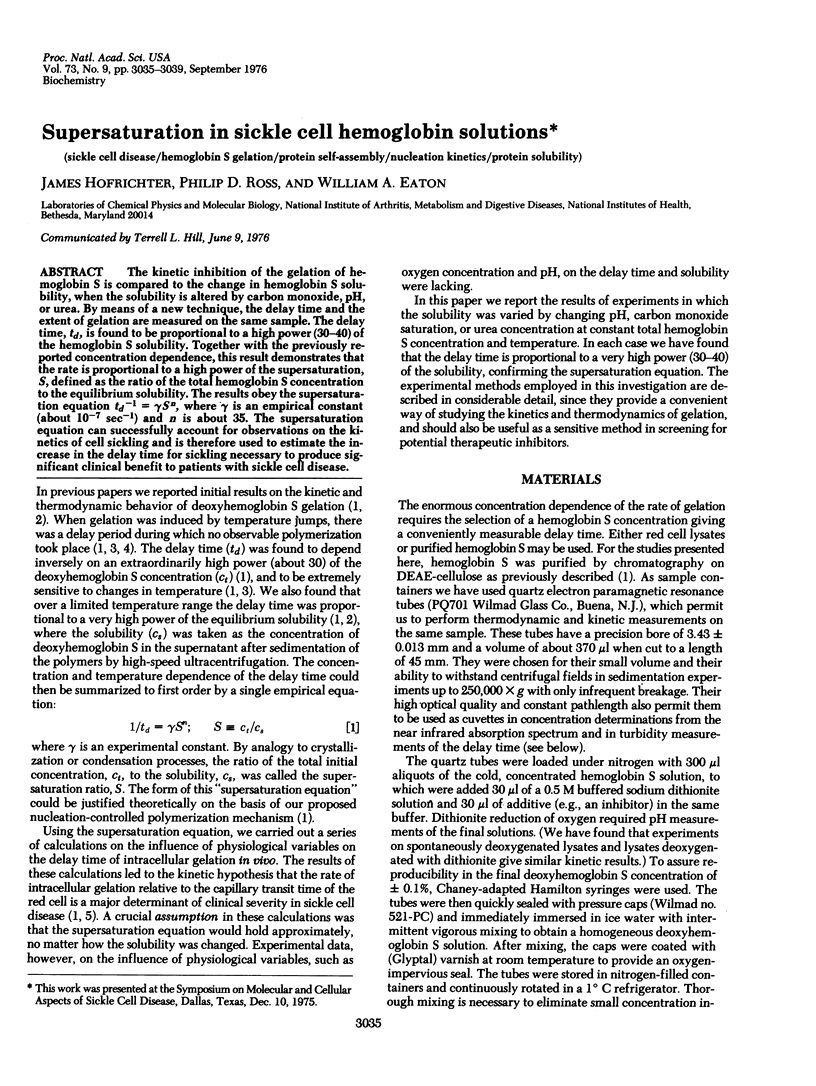
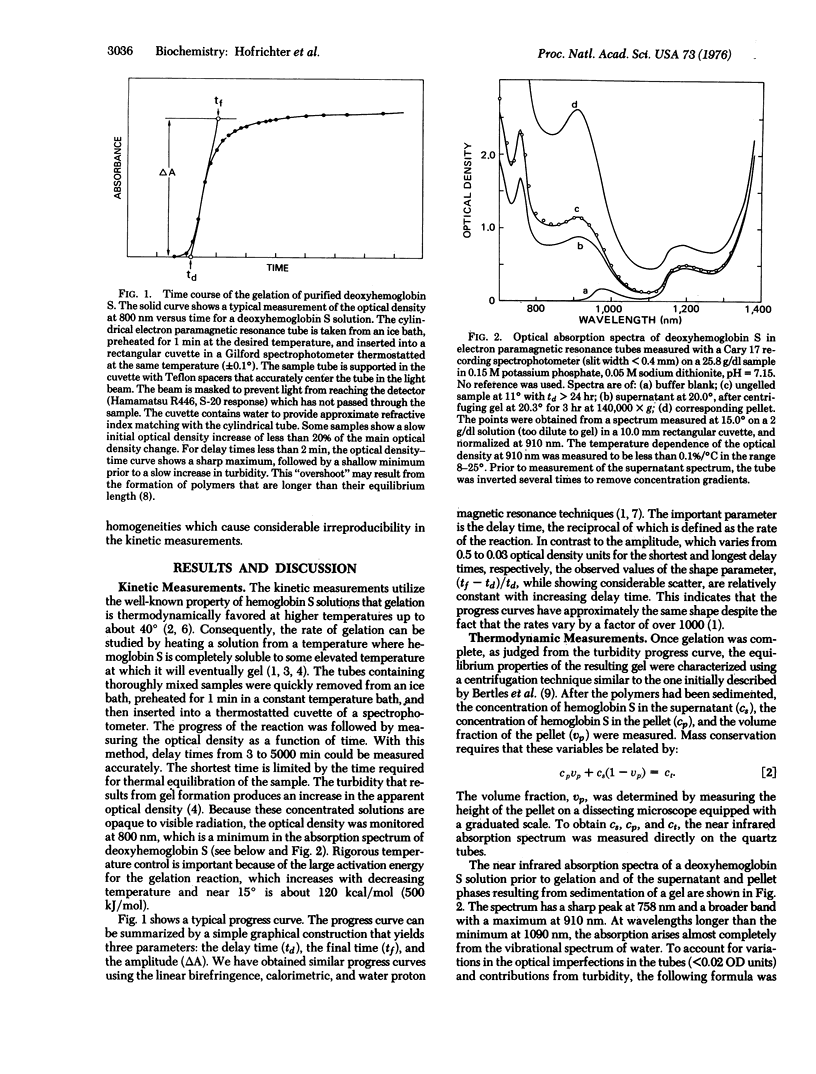
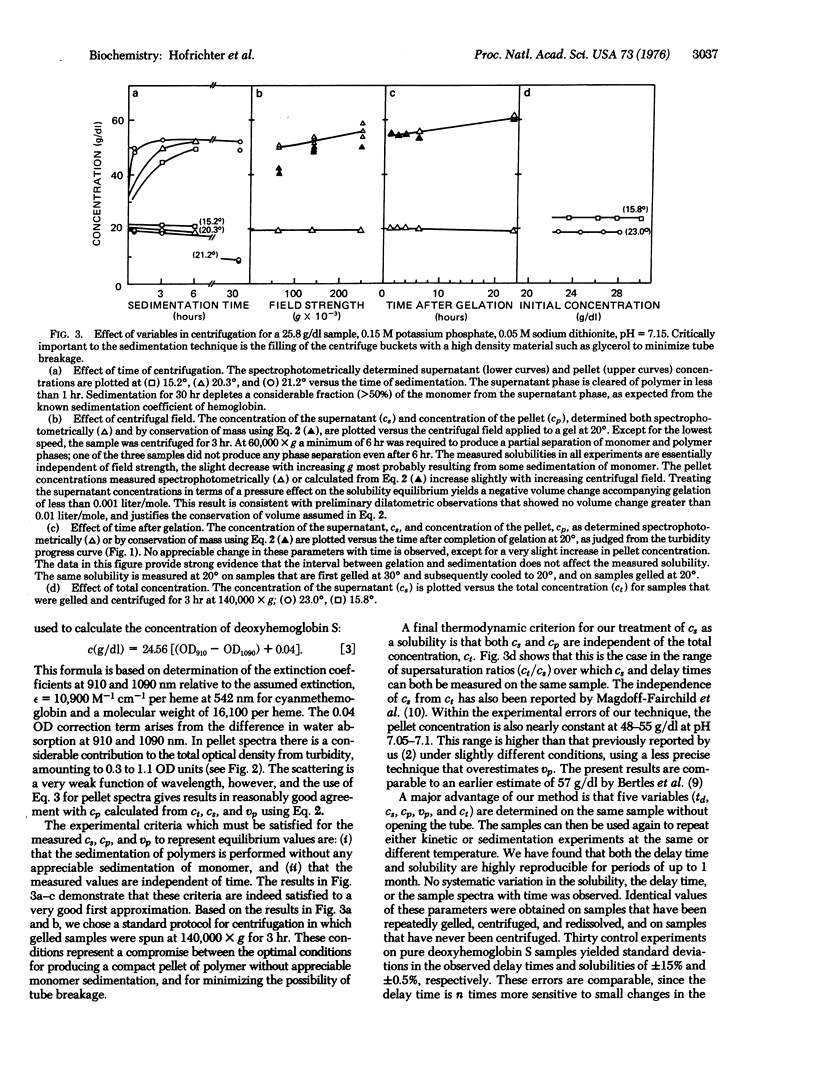
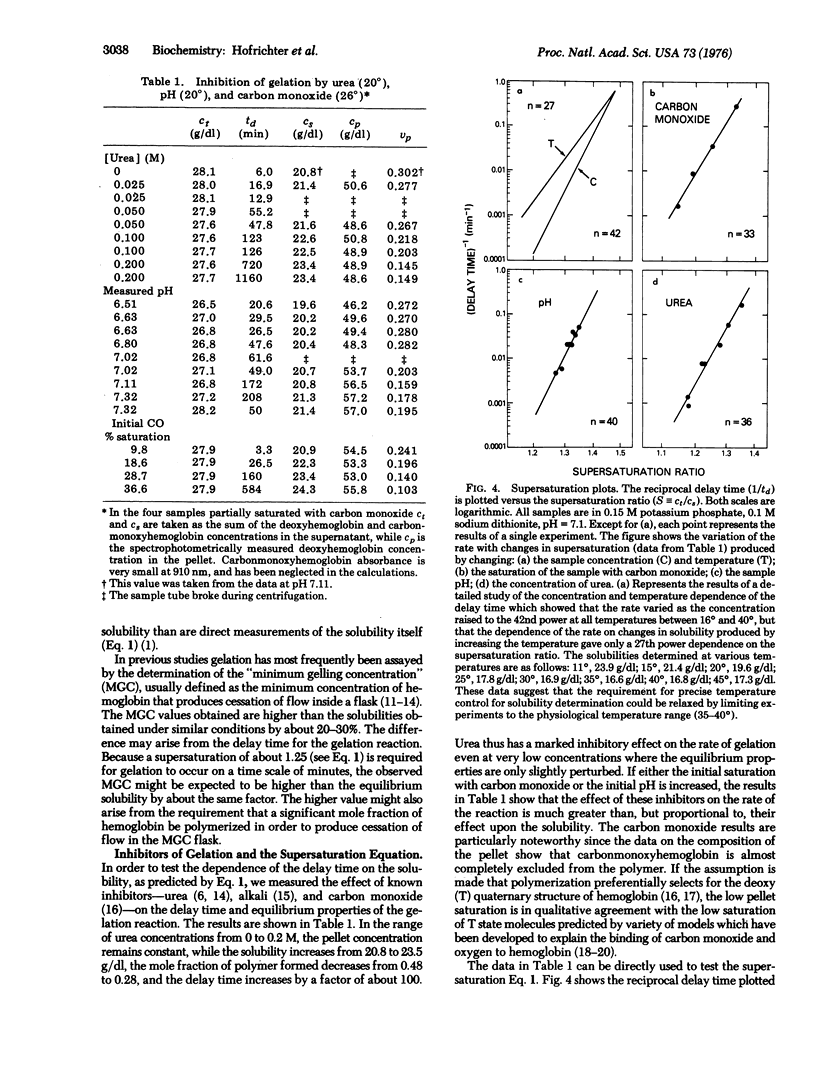
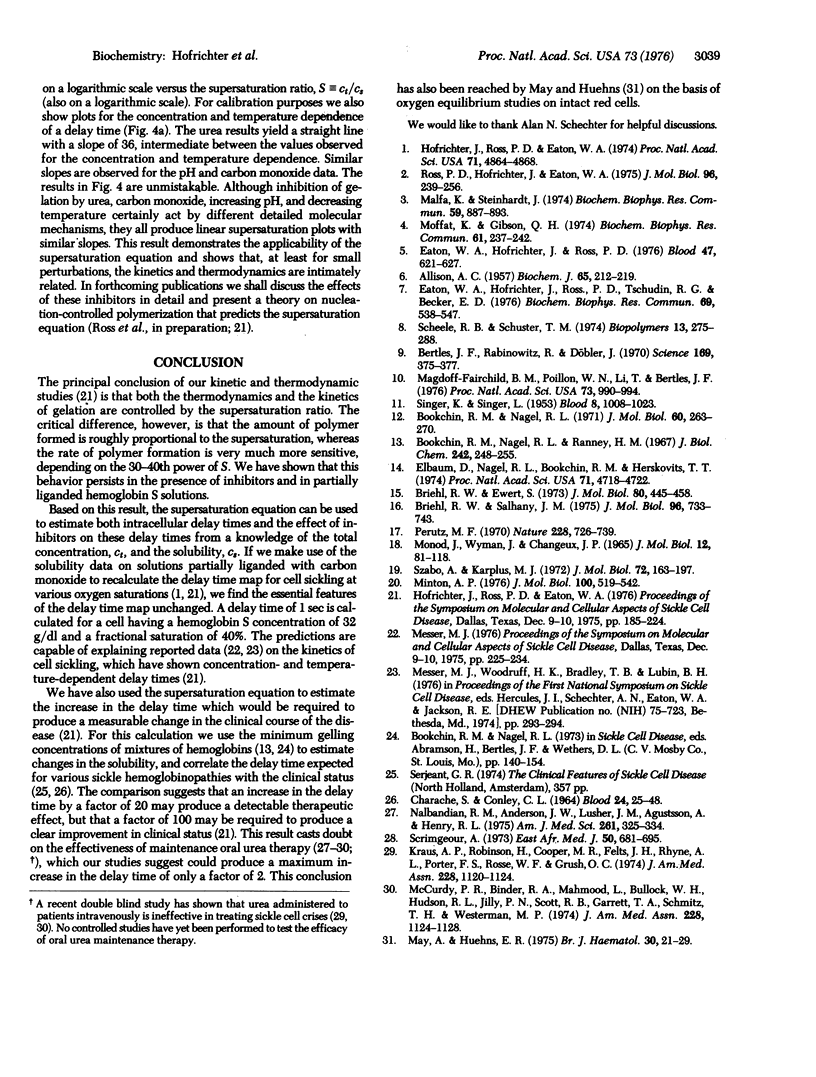
Selected References
These references are in PubMed. This may not be the complete list of references from this article.
- ALLISON A. C. Properties of sickle-cell haemoglobin. Biochem J. 1957 Feb;65(2):212–219. doi: 10.1042/bj0650212. [DOI] [PMC free article] [PubMed] [Google Scholar]
- Bertles J. F., Rabinowitz R., Döbler J. Hemoglobin interaction: modification of solid phase composition in the sickling phenomenon. Science. 1970 Jul 24;169(3943):375–377. doi: 10.1126/science.169.3943.375. [DOI] [PubMed] [Google Scholar]
- Bookchin R. M., Nagel R. L. Ligand-induced conformational dependence of hemoglobin in sickling interactios. J Mol Biol. 1971 Sep 14;60(2):263–270. doi: 10.1016/0022-2836(71)90292-0. [DOI] [PubMed] [Google Scholar]
- Bookchin R. M., Nagel R. L., Ranney H. M. Structure and properties of hemoglobin C-Harlem, a human hemoglobin variant with amino acid substitutions in 2 residues of the beta-polypeptide chain. J Biol Chem. 1967 Jan 25;242(2):248–255. [PubMed] [Google Scholar]
- Briehl R. W., Ewert S. Effects of pH, 2,3-diphosphoglycerate and salts on gelation of sickle cell deoxyhemoglobin. J Mol Biol. 1973 Nov 5;80(3):445–458. doi: 10.1016/0022-2836(73)90415-4. [DOI] [PubMed] [Google Scholar]
- Briehl R. W., Salhany J. M. Gelation of sickle hemoglobin. III. Nitrosyl hemoglobin. J Mol Biol. 1975 Aug 25;96(4):733–743. doi: 10.1016/0022-2836(75)90149-7. [DOI] [PubMed] [Google Scholar]
- CHARACHE S., CONLEY C. L. RATE OF SICKLING OF RED CELLS DURING DEOXYGENATION OF BLOOD FROM PERSONS WITH VARIOUS SICKLING DISORDERS. Blood. 1964 Jul;24:25–48. [PubMed] [Google Scholar]
- Eaton W. A., Hofrichter J., Ross P. D. Editorial: Delay time of gelation: a possible determinant of clinical severity in sickle cell disease. Blood. 1976 Apr;47(4):621–627. [PubMed] [Google Scholar]
- Eaton W. A., Hofrichter J., Ross P. D., Tschudin R. G., Becker E. D. Comparison of sickle cell hemoglobin gelation kinetics measured by NMR and optical methods. Biochem Biophys Res Commun. 1976 Mar 22;69(2):538–547. doi: 10.1016/0006-291x(76)90554-4. [DOI] [PubMed] [Google Scholar]
- Elbaum D., Nagel R. L., Bookchin R. M., Herskovits T. T. Effect of alkylureas on the polymerization of hemoglobin S. Proc Natl Acad Sci U S A. 1974 Dec;71(12):4718–4722. doi: 10.1073/pnas.71.12.4718. [DOI] [PMC free article] [PubMed] [Google Scholar]
- Hofrichter J., Ross P. D., Eaton W. A. Kinetics and mechanism of deoxyhemoglobin S gelation: a new approach to understanding sickle cell disease. Proc Natl Acad Sci U S A. 1974 Dec;71(12):4864–4868. doi: 10.1073/pnas.71.12.4864. [DOI] [PMC free article] [PubMed] [Google Scholar]
- MONOD J., WYMAN J., CHANGEUX J. P. ON THE NATURE OF ALLOSTERIC TRANSITIONS: A PLAUSIBLE MODEL. J Mol Biol. 1965 May;12:88–118. doi: 10.1016/s0022-2836(65)80285-6. [DOI] [PubMed] [Google Scholar]
- Magdoff-Fairchild B., Poillon W. N., Li T., Bertles J. F. Thermodynamic studies of polymerization of deoxygenated sickle cell hemoglobin. Proc Natl Acad Sci U S A. 1976 Apr;73(4):990–994. doi: 10.1073/pnas.73.4.990. [DOI] [PMC free article] [PubMed] [Google Scholar]
- Malfa R., Steinhardt J. A temperature-dependent latent-period in the aggregation of sickle-cell deoxyhemoglobin. Biochem Biophys Res Commun. 1974 Aug 5;59(3):887–893. doi: 10.1016/s0006-291x(74)80062-8. [DOI] [PubMed] [Google Scholar]
- May A., Huehns E. R. The effect of urea on sickling. Br J Haematol. 1975 May;30(1):21–29. doi: 10.1111/j.1365-2141.1975.tb00513.x. [DOI] [PubMed] [Google Scholar]
- Minton A. P. Relations between oxygen saturation and aggregation of sickle-cell hemoglobin. J Mol Biol. 1976 Feb 5;100(4):519–542. doi: 10.1016/s0022-2836(76)80043-5. [DOI] [PubMed] [Google Scholar]
- Moffat K., Gibson Q. H. The rates of polymerization and depolymerization of sickle cell hemoglobin. Biochem Biophys Res Commun. 1974 Nov 6;61(1):237–242. doi: 10.1016/0006-291x(74)90558-0. [DOI] [PubMed] [Google Scholar]
- Nalbandian R. M., Anderson J. W., Lusher J. M., Agustsson A., Henry R. L. Oral urea and the prophylactic treatment of sickle cell disease--a preliminary report. Am J Med Sci. 1971 Jun;261(6):325–334. doi: 10.1097/00000441-197106000-00003. [DOI] [PubMed] [Google Scholar]
- Perutz M. F. Stereochemistry of cooperative effects in haemoglobin. Nature. 1970 Nov 21;228(5273):726–739. doi: 10.1038/228726a0. [DOI] [PubMed] [Google Scholar]
- Ross P. D., Hofrichter J., Eaton W. A. Calorimetric and optical characterization of sickle cell hemoglobin gelation. J Mol Biol. 1975 Aug 5;96(2):239–253. doi: 10.1016/0022-2836(75)90345-9. [DOI] [PubMed] [Google Scholar]
- SINGER K., SINGER L. Studies on abnormal hemoglobins. VIII. The gelling phenomenon of sickle cell hemoglobin: its biologic and diagnostic significance. Blood. 1953 Nov;8(11):1008–1023. [PubMed] [Google Scholar]
- Scheele R. B., Schuster T. M. Kinetics of protein subunit interactions: simulation of a polymerization overshoot. Biopolymers. 1974;13(2):276–288. doi: 10.1002/bip.1974.360130204. [DOI] [PubMed] [Google Scholar]
- Scrimgeour A. Urea therapy in sickle cell disease: a report of 38 treated cases. East Afr Med J. 1973 Dec;50(12):681–695. [PubMed] [Google Scholar]
- Szabo A., Karplus M. A mathematical model for structure-function relations in hemoglobin. J Mol Biol. 1972 Dec 14;72(1):163–197. doi: 10.1016/0022-2836(72)90077-0. [DOI] [PubMed] [Google Scholar]


